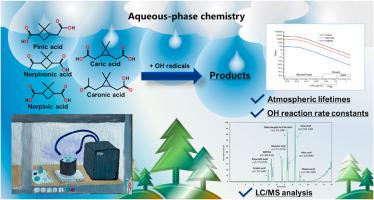α-蒎烯和δ-3-蒈烯衍生SOA组分在水相OH自由基作用下形成萜烯酸及其动力学研究
IF 3.7
2区 环境科学与生态学
Q2 ENVIRONMENTAL SCIENCES
引用次数: 0
摘要
在本研究中,测量了羟基自由基在水中氧化松子酸、石炭酸、石炭酸、去甲蒎酸和去甲蒎酸的双分子反应速率系数(kOH, L mol−1s−1)。此外,对所研究的OH反应生成的产物进行了定量分析,包括文献中已知的产物,α-蒎烯和δ-3-蒈烯的SOA组分。在288 ~ 308 K的温度范围内,测量了所研究的萜烯酸的中性(pH = 2)和去质子化(pH = 10)形式的kOH值。与去甲蒎酸(kOH298K pH2 = 1.2±0.1 × 109 L mol - 1s−1)、去甲蒎酸(kOH298K pH2 = 1.1±0.1 × 109 L mol - 1s−1)和松果酸(kOH298K pH2 = 2.1±0.1 × 109 L mol - 1s−1)相比,羰基酸和石炭酸与OH自由基的反应(kOH298K pH2 = 3.3±0.1 × 109 L mol - 1s−1)略快。计算的活化能(E)在9-21 kJ mol−1范围内,解释了测量的反应速率对温度的依赖性非常弱。计算出的寿命随着LWC的增加而减少(从气溶胶中的10−12 m3 m3到风暴中的10−5 m3 m−3),表明在实际大气条件下,酸经历了显著的水处理。通过对极低挥发性产物的分析,提出了α-蒎烯从早期到晚期产物(仅羧酸)的反应路径。我们测定了去甲蒎酸可以通过水相OH反应生成萜戊酸,也可以通过萜戊酸氧化生成萜戊酸。此外,我们发现萜烯酸+ OH自由基的反应比松果酸和松果酸的氧化反应慢近10倍。因此,在大气中观察到,萜烯酸的形成主要是通过α-蒎烯(蒎酸和蒎酸)的早期氧化产物直接氧化而不是通过萜烯酸的二次反应。本文章由计算机程序翻译,如有差异,请以英文原文为准。

Formation and kinetics of terpenoic acids from α-pinene and δ-3-carene-derived SOA components via aqueous-phase OH radicals
Bimolecular reaction rate coefficients (kOH, L mol−1s−1) for the aqueous oxidation of pinic, caric, caronic, norpinic, and norpinonic acids by OH radicals were measured within the presented study. Furthermore, a quantitative analysis was performed for selected products formed in the studied OH reactions, including those known in the literature, SOA components of α-pinene and δ-3-carene. Values of kOH were measured for the neutral (pH = 2) and deprotonated (pH = 10) forms of the terpenoic acids under investigation in the temperature range between 288 and 308 K. The reactions of caronic and caric acids with OH radicals appear slightly faster (kOH298K pH2 = 3.3 ± 0.1 × 109 L mol−1s−1 and kOH298K pH2 = 3.3 ± 0.1 × 109 L mol−1s−1, respectively) than those of norpinic (kOH298K pH2 = 1.2 ± 0.1 × 109 L mol−1s−1), norpinonic (kOH298K pH2 = 1.1 ± 0.1 × 109 L mol−1s−1) and pinic acids (kOH298K pH2 = 2.1 ± 0.1 × 109 L mol−1s−1). The calculated activation energies (E) fall in a 9–21 kJ mol−1 range, explaining the very weak temperature dependence of the measured reaction rates. The calculated lifetimes decreased with increasing LWC (from 10−12 m3 m3 in aerosol to 10−5 m3 m−3 in storms), indicating that the acids undergo significant aqueous processing under realistic atmospheric conditions. The analysis of extremely low-volatility products allowed proposing reaction paths from earlier– to later–generation products (only carboxylic acid) of α-pinene. We measured that terebic acid can be formed through the aqueous phase OH reaction of norpinic acid, but also through terpenylic acid oxidation. Moreover, we found that the reaction of terpenylic acid + OH radicals is almost 10 times slower than the oxidation of pinic and pinonic acids. Therefore, observed in the atmosphere, terebic acid formation is mainly through direct oxidation of an early-generation oxidation product of α-pinene (pinic and pinonic acids) rather than from the secondary reaction of terpenylic acid.
求助全文
通过发布文献求助,成功后即可免费获取论文全文。
去求助
来源期刊

Atmospheric Environment
环境科学-环境科学
CiteScore
9.40
自引率
8.00%
发文量
458
审稿时长
53 days
期刊介绍:
Atmospheric Environment has an open access mirror journal Atmospheric Environment: X, sharing the same aims and scope, editorial team, submission system and rigorous peer review.
Atmospheric Environment is the international journal for scientists in different disciplines related to atmospheric composition and its impacts. The journal publishes scientific articles with atmospheric relevance of emissions and depositions of gaseous and particulate compounds, chemical processes and physical effects in the atmosphere, as well as impacts of the changing atmospheric composition on human health, air quality, climate change, and ecosystems.
 求助内容:
求助内容: 应助结果提醒方式:
应助结果提醒方式:


